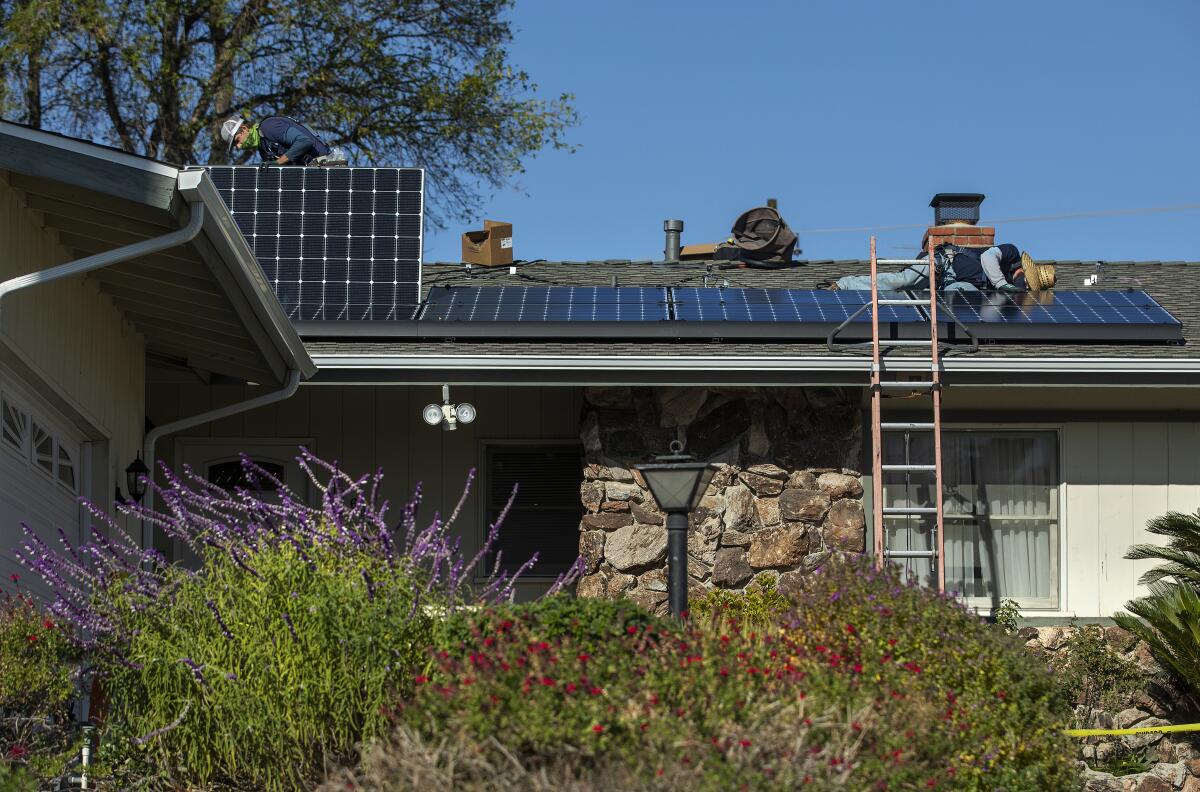Editorial: Don’t turn the lights out on California’s solar rooftop revolution

California is betting big on a not-too-distant future in which burning fossil fuels to cool homes or propel cars is just a bad memory, and all power comes from clean, renewable sources like the sun, wind and water. It’s a bold goal that will require visionary and sometimes uncomfortable leadership to achieve.
That’s why it’s bewildering that state regulators would even consider undermining one of the state’s most successful green power revolutions — small rooftop solar arrays — especially after taxpayers invested more than $3 billion in rebates to get the market moving.
And get moving it did. Twenty-five years ago there were about 10,000 rooftop solar power systems on homes, businesses and public buildings across this vast and sunny state. Today, there are more than 1.2 million, accounting for more than half of all of the small rooftop solar units in the entire United States. And that number is still growing.
But some believe that so many homeowners have installed solar panels, the subsidies that spurred this growth are now unfairly burdening those who can’t afford a solar array (which currently costs about $17,000 after federal tax credits for an average-sized system). In response, the California Public Utilities Commission is seeking to reduce or even eliminate one of those subsidies: the requirement that power companies give solar customers credit for the excess electricity their systems generate and send back to the grid, which can be used later when the sun isn’t shining.
The credits are a pretty sizable bonus on top of the savings that come from harvesting the rays of the sun, and it’s appropriate for regulators to scale them back now that solar panels are much more affordable than they were just a decade ago. But the PUC should not give in to calls to slap burdensome fees on future solar panel owners, or it will risk sending California back to a time when solar panels were affordable only to the wealthy.
A case in point is the joint proposal submitted by the state’s three biggest power companies, Pacific Gas & Electric, Southern California Edison and San Diego Gas & Electric. These investor-owned utilities are asking the commission not only to reduce the value of credits to something closer to the cost for electricity on the open market, which is reasonable, but also to charge solar customers a flat monthly fee as high as $90, which is not.
The companies, whose shareholders are guaranteed a generous return on their investment, argue that the fees are needed to cover the true cost of being connected to the power grid. Electrical rates include the cost not just to buy each kilowatt, but also to maintain the transmission system, fund initiatives to reduce wildfires sparked by power lines and finance the shift to renewable energy, among other programs. Because of those costs, the utilities claim, when solar-powered households buy less electricity, everyone else has to subsidize them through higher rates. Currently, all customers have to pay a small minimum charge each month, no matter how little power they use, to ensure that they are supporting the grid.
The proposed fees seem designed to discourage solar installations rather than right some structural inequity. The combination of a large monthly fee and a smaller solar credit would make solar less affordable. And don’t think that means sticking it just to wealthy coastal elites. The change wouldn’t apply to current solar customers, who tend to be wealthier, but to the next generation of buyers. According to the solar industry, more than half of new customers are middle- or working-class homeowners. As a report by Berkeley Labs put it, “Adoption has been gradually migrating toward lower income ranges over time, reflecting both a broadening and a deepening of U.S. solar market.”
It’s disappointing that the debate has been cast in such binary terms that pit ratepayers against each other. Electrical rates in California are among the highest in the nation, but that’s not the fault of those who can afford to reduce their exposure to volatile electrical prices by installing energy-efficient appliances or solar panels. Solar arrays benefit every electricity consumer, not just the homeowners who have them. Not only do they help reduce the state’s use of fossil fuels, but if paired with storage they can supply power to the grid during times of peak demand — and without requiring more transmission lines through wildfire-prone areas.
Solar rooftops alone, even with batteries to store the excess power generated, are not going to serve all of California’s green power needs. That will require large-scale renewable power plants and the lines to connect them. But rooftop solar is an important part of the formula, and California would be unwise to do anything that pushes them out of reach of millions of homeowners.
More to Read
A cure for the common opinion
Get thought-provoking perspectives with our weekly newsletter.
You may occasionally receive promotional content from the Los Angeles Times.










